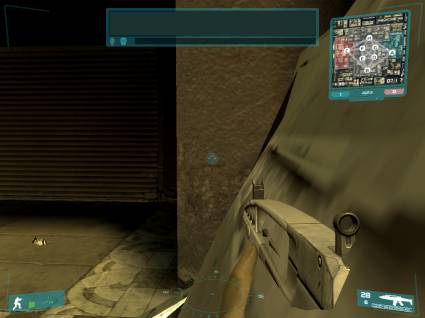Can Ageia's PhysX Card Bring Real-World Physics to Games?
PhysX Card Vs. Software Physics
The next question is obviously what differences the card makes during game play. To determine this, we used Ghost Recon Advanced Warfighter as our test title. We limited our testing procedure to real-world conditions, meaning we installed the game as if it had been purchased through normal retail channels, without additional patches or tweaks. It is coded to take advantage of the Ageia card without any restrictions or tricks. Expect to see an update of this article once other games with PhysX support are released, such as Sacred II, Unreal 2007 or Monster Madness.
Without hardware acceleration, the tires partially disappear in the ground. This type of clipping error has been around since the days of the original Tomb Raider 1 and has no place a modern game.
Although objects such as tires and doors can be moved into each other by firing on them with weapons, the player can't manipulate them directly. Without dedicated physics hardware, the player's avatar simply moves through them as if they weren't there.
In software physics mode, the game's 3D engine fails to impress. At the beginning of levels, the tires of parked vehicles sink into the pavement.
This problem doesn't improve even when the game utilizes Ageia hardware. Destroyed vehicles still sink into the ground.
The PhysX card also can't prevent the clipping errors with intersecting objects. Tires and doors can still be pushed into (and through) one another. The moveable objects are still not treated as though they were solid matter. Despite PhysX hardware support, the player's avatar is still able to walk through objects.
You might be asking yourself how this can be? There are three engines in a game: game engine, physics engine, and the effects engine. The two forms of physics engines are the latter, gameplay physics and effects physics. Each are separate "physics" engines. In the case of Ghost Recon Advanced Warfighter, Ageia was implemented to do the effects physics and Havok for the gameplay physics. The gameplay physics is done on the CPU while the effects physics can be done on the CPU via the software SDK, or accelerated in hardware via the PPU add-in card. So when you look at the implementation of effects, clipping of a car is not dictated by the PhysX engine, but by the Havok engine, as Ageia is only doing the effects portion of the physics. When the effect is over, the gameplay engine and gameplay physics engine will take that object and interact with it normally. This could mean that an object sinks into the ground or become immovable.
Get Tom's Hardware's best news and in-depth reviews, straight to your inbox.
The cover of the garbage can is sent flying with every explosion. However, it doesn't pose an obstacle for the player's avatar, even when PhysX hardware is installed.
The Ageia card adjusts the weight of movable objects. For some reason, they are suddenly super heavy, which is why we can see this blown-out door stand on its thin edge here instead of tipping over. The same thing can happen to tires. While they no longer sink into the ground when fired upon, they often remain standing at very unnatural and unlikely angles.
The major effect the PhysX card seems to add to games is how the weight of in-game objects, such as vehicle doors and tires, is altered. Somehow it feels as though these objects react a lot more stiffly when they are struck by bullets. However, the device does not prevent the clipping errors. Tires almost always partially disappear in the ground after grenades explode near them, regardless of whether the PhysX card is installed or not. On the whole, it does not feel as though the PhysX engine and the PhysX acceleration hardware are working in close harmony, yet.
Current page: PhysX Card Vs. Software Physics
Prev Page Installing The PhysX Card, Continued Next Page Ageia Hardware In Action





